
Charles Augustus Leale was a surgeon in the Union Army during the American Civil War and the first doctor to arrive at the presidential box at Ford's Theatre on April 14, 1865 after John Wilkes Booth fatally shot President Abraham Lincoln in the head. His prompt treatment allowed Lincoln to live until the next morning. Leale continued to serve in the army until 1866, after which he returned to his home town of New York City where he established a successful private practice and became involved in charitable medical care. One of the last surviving witnesses to Lincoln's death, Leale died in 1932 at the age of 90.

Yonkers Public Schools is a school district that serves all of Yonkers, New York, United States. It is governed by a mayorally appointed Board of Trustees.

This is a list of the National Register of Historic Places entries in Yonkers, New York. See also National Register of Historic Places listings in Westchester County, New York for all others in the county.

St. Bridget's Roman Catholic Church Complex is a historic Roman Catholic church complex located at Bloomfield in Ontario County, New York. The complex consists of three contributing buildings and one contributing site, the church cemetery. the church is a late Victorian eclectic brick edifice with restrained Italianate and Romanesque Revival–style design and decorative features. It features a square, wood bell tower. The rectory is a 2+1⁄2-story Colonial Revival–style frame building and features a verandah with Doric order columns. A 1+1⁄2-story carriage barn stands behind the rectory. The six-acre cemetery includes burials dating from 1866 to 1942.
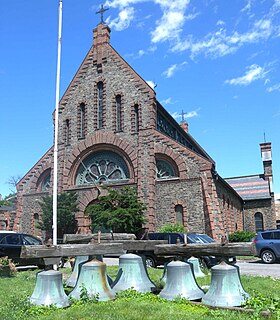
St. John's Protestant Episcopal Church is a historic Episcopal church at One Hudson Street in the Getty Square neighborhood of Yonkers, Westchester County, New York. The complex includes the church, chapel, rectory, parish house, and school. The church was originally constructed in 1752, with an addition in 1849, and modifications to the front facade in 1874 by architect Edward Tuckerman Potter (1831–1904). It is constructed of rough gray fieldstone with red brick on the corners. It is cruciform in plan, three bays wide, with a slate-covered gable roof. The front facade features a rose window and four battered buttresses. The parish house and chapel were constructed in 1890–1891 and are connected to the church. The 2+1⁄2-story, five-bay-wide rectory was also constructed in 1890–1891 and is connected to the chapel. The additions made during 1890–1891 were by architect Robert Henderson Robertson (1849–1919). A group of women from the church founded St. John's Riverside Hospital in 1869 to care for the poor of the parish.
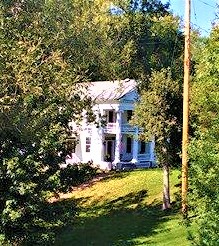
Schroeppel House is a historic home located in Schroeppel in Oswego County, New York. The original section was built in 1818 and is a Neoclassical-style structure. The principal mass is a three- by four-bay, 2+1⁄2-story frame house constructed in the style of a prostyle tetrastyle temple. It features a 2-story portico with Ionic columns. The house is currently used as a bed and breakfast called River Edge Mansion.
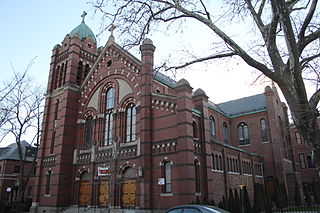
Saint Benedict Joseph Labre Parish is a historic Roman Catholic parish church complex in the Diocese of Brooklyn, located at 94-40 118th Street in Richmond Hill, Queens, New York City.
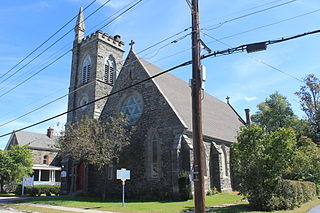
St. John's Episcopal Church and Rectory is a historic Episcopal church at 15 St. John's Street in Monticello, Sullivan County, New York. It was built between 1879 and 1881 and is "L" shaped in plan, consisting of the church and an attached chapel. It is built of quarry-faced, randomly laid coursed stone. The church features a tall, engaged corner three stage entrance tower with a crenellated top.
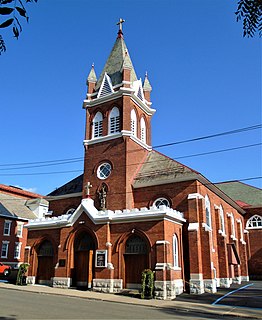
Saint Stanislaus Roman Catholic Church Complex is a historic Roman Catholic church complex at 42, 46, 50 Cornell Street, and 73 Reid Street in Amsterdam, Montgomery County, New York. The complex consists of four contributing buildings:

St. John the Baptist Roman Catholic Church and Rectory is a historic Roman Catholic church and rectory located at 20 Broad Street in Plattsburgh, Clinton County, New York. Both structures were added to the National Register of Historic Places as one record in 1982.
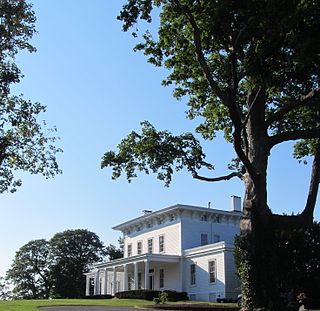
John P. Kane Mansion, also known as High Lindens, is a historic home located at Huntington Bay in Suffolk County, New York. It was built about 1850 and is a three-story, flat roofed clapboard residence with deep overhanging eaves on massive scrollsawn brackets which frame frieze windows. It is representative of the Italianate style.

The Benjamin N. Duke House, also called the Duke–Semans Mansion and the Benjamin N. and Sarah Duke House, is a landmarked mansion located at 1009 Fifth Avenue at East 82nd Street in the Upper East Side of Manhattan, New York City. It was built in 1899-1901 and was designed by the firm of Welch, Smith & Provot in the Beaux-Arts style.

The W. B. Thompson Mansion, also known as Alder Manor, is a historic home located on North Broadway in the Greystone section of Yonkers, New York, United States. It is an early 20th-century mansion designed by Carrère and Hastings in the Renaissance Revival architectural style. In 1982, it was listed on the National Register of Historic Places.

Glenview Mansion, listed on the National Register of Historic Places as the John Bond Trevor House, is located on Warburton Avenue in Yonkers, New York, United States. It is a stone house erected during the 1870s in an eclectic Late Victorian architectural style from a design by Charles W. Clinton. It was listed on the Register in 1972.

Public Bath House No. 3, also known as Yonkers Avenue Pool, is a historic public bath located on the border of the Getty Square and Nodine Hill neighborhoods in Southwest Yonkers, Westchester County, New York. It was built in 1909 and is a two-story, five bay wide red brick building with lively tile ornamentation in the Second Renaissance Revival style. It features a hipped tile parapet at the roofline that hides the flat roof. The interior is in three sections: reception area, custodian's apartment, and a pool and showers. It was remodeled in 1930 and 1958.

Yonkers Water Works is a historic public water works located at Yonkers, Westchester County, New York. Three buildings remain extant; two were built in 1876 and one in 1898. They are reflective of the High Victorian style. The Tuckahoe Road Pumping Station was built in 1876 and expanded before 1900. The original section is three bays wide and three bays deep with a central projecting pavilion and pedimented gable roof. The gatehouse at Grassy Sprain Reservoir was also constructed in 1876. It is a small, one story masonry building on a high granite foundation. The Tubewell Station was built in 1898 and expanded in 1922. It is a red brick building, one and one half stories high and five bays wide and 13 bays deep.

Bell Place–Locust Avenue Historic District is a national historic district located at Yonkers, Westchester County, New York. It includes 11 contributing buildings. They are residential structures and outbuildings representative of the High Victorian, Italian Villa, and Second Empire styles. They were built between 1855 and 1887 and consists of medium-sized, single family residences, between two and three stories in height. Some have extant carriage houses on their properties.

The Alexander Smith Carpet Mills Historic District is a national historic district located at Yonkers, Westchester County, New York. It includes 85 contributing buildings. It encompasses 19 stylistically varied mill buildings and six rows of workers' housing. They were developed between 1871 and 1930 in the vicinity of northeastern Getty Square along the banks of the Saw Mill River. The main mill building was originally built in 1871 and expanded between 1876 and 1883. It is a three-story, rectangular building, 52 bays wide and five bays deep in the Second Empire style. It features a four-story tower and a five-story tower. The workers' housing, known as Moquette Row, North and South, was built between 1881 and 1886. Many workers that lived in this housing originally were immigrants to the United States. They came from Scotland, Ireland, and Ukraine. The carpet works were developed by Alexander Smith (1818-1878) The company closed the Yonkers mills and relocated to Greenville, Mississippi, in 1954. At the time of its closing, there were 2,400 who worked at the carpet mill. At the time of World War II, there was 7,000 employees who worked at the mill.It was later absorbed into Mohawk Carpet, later Mohasco Corporation. The carpet weaving industry was revolutionized by looms invented in this plant by Alexander Smith and Halcyon Skinner. Skinner, an engineer, designed a loom known as the Axminster power loom, which revolutionized the production of carpets. A patent for this loom was created in 1877 and royalty rights were sold to European and American companies at the rate of twenty cents per yard of carpet produced.

The Gov. James W. Nye Mansion, at 108 N. Minnesota St. in Carson City, Nevada, United States, was built in 1860. It has also been known as St. Teresa's Rectory. It was a home of U.S. senator William M. Stewart and of Nevada territory governor James W. Nye.

St. Matthias Roman Catholic Church Complex is a historic Roman Catholic church complex located in the Ridgewood neighborhood of Queens County, New York. The church was built in 1926, and is an Italian Renaissance Revival style, brick, stone, and terra cotta church with a gable roof. It features a three-stage bell tower at the projecting center bay and Corinthian order columns. Also on the property are the contributing four-story rectory (1910), school, and convent (1914).
























